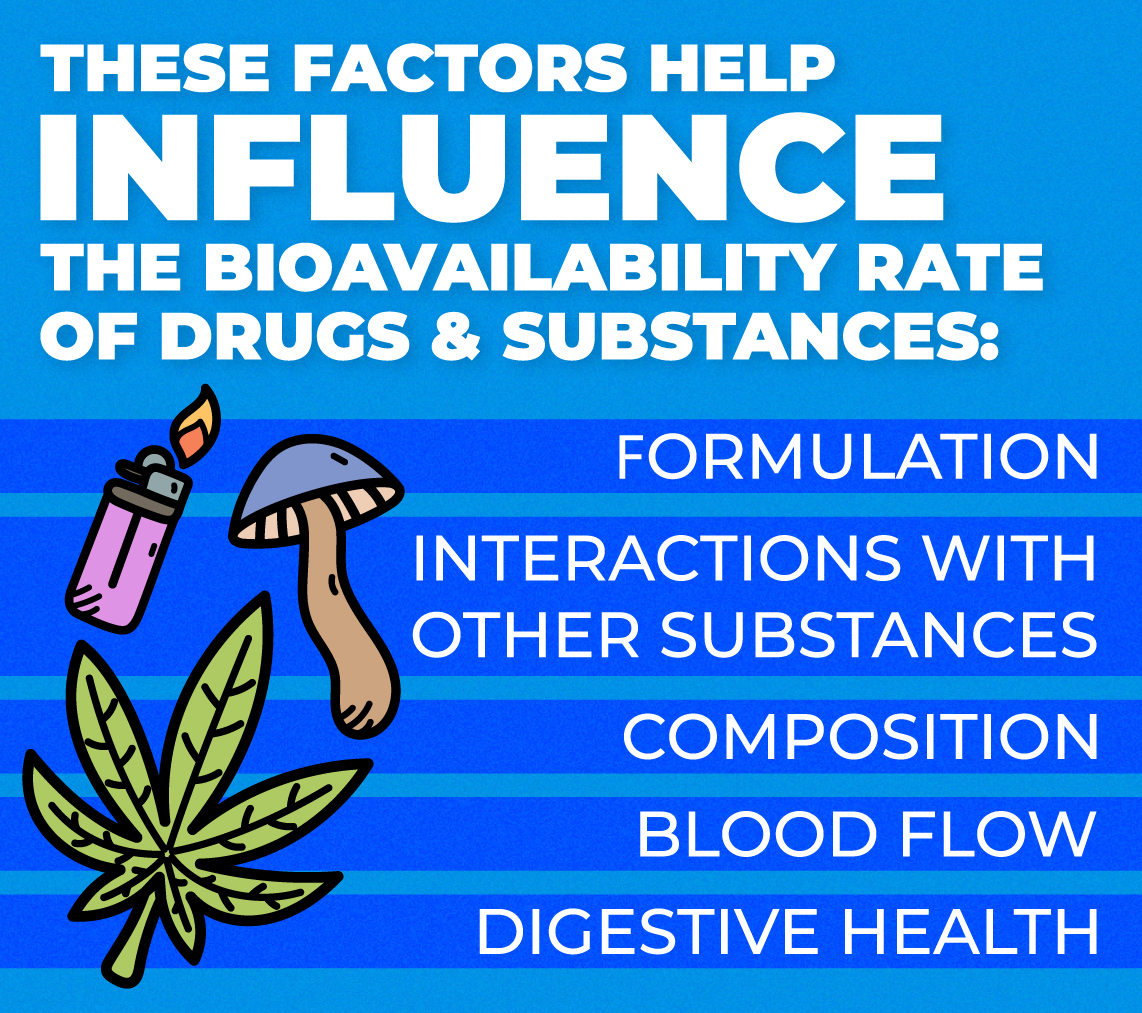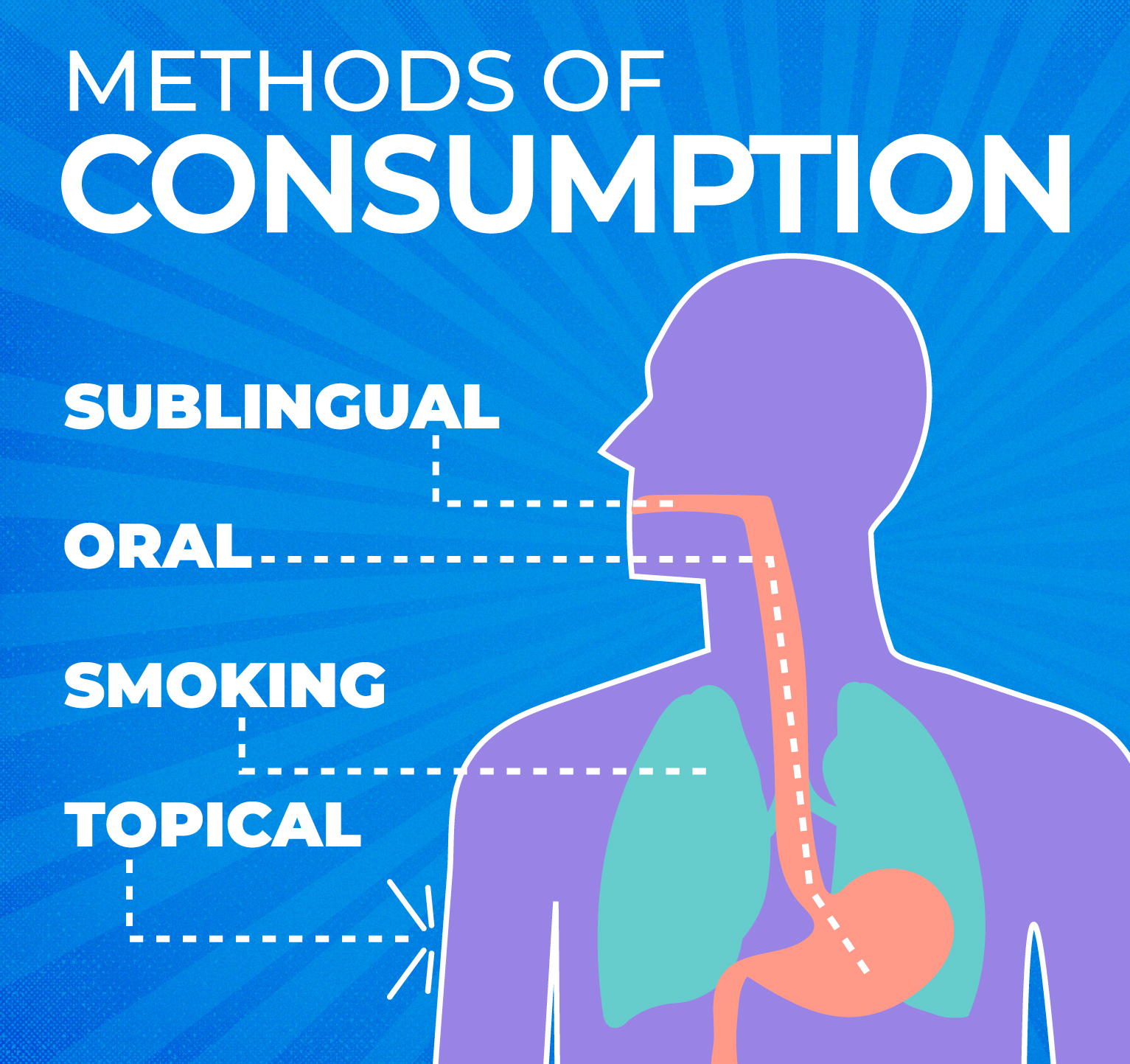
When you read the packaging on your medicinal cannabis products, do you get excited when you see the potency percentage? Many equate high-potency marijuana products with stronger therapeutic and psychoactive effects. But it’s important not to rely solely on what’s listed on the packaging.
Fancy and colorful packaging are among the standard marketing gimmicks manufacturers use to sway customers into purchasing their products. So it’s best to take what you see on the label with a grain of salt.
If you’re ready to learn why certain consumption methods or marijuana products don’t hit as strongly as expected or desired, it’s time to take a deeper look at bioavailability.
Many are unaware that the therapeutic benefits of cannabis come from its cannabinoids and their rate and amount of absorption into the bloodstream — bioavailability.¹ In order for users to experience the therapeutic effects of cannabis, it must be taken in a form that’s easily absorbable by the body.
There are several different administration methods for cannabis. Besides smoking and vaping, users can eat or drink, apply topically to the skin, or insert their medicinal marijuana treatments. In an ideal world, the body utilizes every bit of the nutrients it receives from administered substances. However, in reality, the body can only absorb a portion of those nutrients.
Absolute bioavailability (100% bioavailability²) is impossible unless a substance is administered intravenously into the bloodstream. Injection directly into the blood allows cannabinoids to bypass the liver, causing users to feel the effects much faster and more intensely.
It’s necessary to dig a bit deeper into the molecular properties of cannabis to understand what affects its bioavailability. Cannabinoids are fat-soluble molecules, meaning they are absorbed much faster and in higher concentrations by the fatty tissues of the body before redistribution to the bloodstream. Cannabinoids are also attracted to the organs in the body with high blood flow.
Its lipophilicity is among several reasons why there are differences in marijuana bioavailability and consumption methods. In order for patients to achieve the full benefits of their medical marijuana treatments, they’ll need to take into account their dosing method and bioavailability.
Cannabis contains hundreds of molecular compounds known as terpenes and cannabinoids. The most studied cannabinoids include THC, CBD, and CBN. Research remains limited on the cannabinoid content in the marijuana plant, and there is evidence highlighting the impact of bioavailability based on the delivery method.
When determining a substance’s bioavailability, it’s necessary to account for the following key factors:
Method of delivery or consumption plays one of the most critical roles in determining marijuana’s bioavailability.

Taking cannabis orally by mouth causes it to be metabolized by the liver or absorbed into the bloodstream³ in order for users to experience the effects. However, before the nutrients and cannabinoids get there, they must first enter the gastrointestinal system to be broken down and processed. Much of the substance’s potency is limited by the time it leaves the digestive tract. Cannabinoids pass through the liver with little absorption, even though the user may be experiencing extremely strong psychotropic effects.
Have you ever wondered why some people seem to have really intense experiences or reactions after eating cannabis edibles? A common culprit is 11-OH-THC, a THC psychotropic up to four times more potent.
There’s so much going on inside your digestive system when you eat cannabis. As the substance comes in contact with gastric secretions, it starts to metabolize and converts cannabinoids into metabolites. 11-hydroxy tetrahydrocannabinol (11-hydroxy-THC or 11-OH-THC) is the main metabolite in THC.
Let’s not forget the other factors in bioavailability involving oral delivery. The body absorbs certain substances or molecules better than others— formulation. And although the body is predominantly an aqueous environment, the digestive system has an affinity for fats or fat-soluble substances.
Cannabis can be converted into concentrated oils and tinctures for sublingual dosing. Sublingual administration allows users to place several drops of liquid under their tongue for fast absorption directly into the bloodstream. Because sublingual dosing bypasses the digestive system, bioavailability is significantly higher than other methods of use for cannabis. Studies show oral bioavailability reaching 75%.
Users with swallowing or reflex difficulties or who prefer to take their medicinal cannabis treatments orally can also utilize the buccal method. It involves placing their marijuana medicine into the deep pocket of the cheeks between the teeth and gums.
When taking cannabis tinctures sublingually, it’s best to place the desired number of drops under the tongue and to avoid swallowing or moving the liquid around for at least 30 to 60 seconds. This optimizes absorption and lessens the amount that gets processed by the digestive system. Regarding the speed of delivery, sublingual administration ranks second behind smoking/vaping.
This leads us to why some people reportedly experience little to no effects after consuming marijuana edibles and baked goods. In order for users to fully experience the full physical effects of marijuana, they would have to be in perfect health. They would also need to use cannabis products optimized for absorption and effectiveness.
These conditions are not practical and are nonexistent. That’s not to say that those of average or less-than-ideal health can’t benefit from using cannabis. But, they may need to use cannabis more frequently or increase their doses sooner to achieve the desired outcome.
Bioavailability varies significantly among cannabis users. Moreover, numerous considerations exist, such as the formulation of cannabis consumed, the user’s age, metabolic rate, digestive health, and food and drug sensitivities.
Millions of people medicate their symptoms away with marijuana. Numerous studies highlight its efficacy for certain health ailments and diseases and mounting pressure across the country to decriminalize it. But some medical conditions, especially those that impact the digestive system or certain vascular organs, can torpedo the bioavailability or efficacy of marijuana products taken orally.
In other words, users with inflammation in their stomach or gastrointestinal disorders, or poor vascular health are likely to have lower absorption rates. They are most likely to experience weaker effects when eating cannabis.
Marijuana can also be made into creams, balms, ointments, lotions, and transdermal patches for patients to apply to their skin. Topical applications absorb through the skin into the bloodstream. Marijuana topicals send cannabinoids into the body to attach and interact with certain receptors in the skin, bones, and nerves. Currently, there’s no clinical evidence on the actual effects or bioavailability of transdermal and topical cannabis products.
Not everyone chooses to smoke, vape, or eat marijuana. Many users rely on marijuana suppositories to relieve their ailments. Evidence is limited on the bioavailability of cannabis administered rectally⁴, but claims indicate it ranges from 13.5% to 40%.
These are fast-acting administration methods for users seeking immediate symptom relief, but the effects tend to wear off much faster. Inhaling cannabis smoke and vapor allows cannabinoids to bypass the gut and enter directly into the bloodstream. Clinical studies place the bioavailability of smoking and vaping anywhere between 2% to 56%.
Smoking and vaping are also prevalent among cannabis users. But, it’s also the least efficient administration method. Smoking burns and wastes a good portion of smoked cannabis flower, and much of its cannabinoid content is also lost as smoke.
New medicinal cannabis products are manufactured all the time. Medical marijuana dispensaries across the country always get new medicinal cannabis products. Nasal sprays are a recent addition that is very popular with the medical cannabis community. Not only do intranasal medical marijuana treatments have a reported bioavailability of up to 46%, but they also have a quick onset time. Most users notice the effects within the first 10 minutes of use.
Thanks to an overwhelming demand for cannabis across the country, some question THC bioavailability and how different consumption methods may impact it. Smoking may be the most preferred way to use cannabis, but its risks and lower bioavailability pale compared to consumable marijuana products. Incorporating marijuana oil into edibles or taking tinctures increases its effects or potency because they are metabolized by the body and take longer to wear off.
Smoking only has air and water vapor as carriers to transport cannabis cannabinoids into the smoker’s airways for distribution throughout the body. Remember, the body also requires fatty acids and oils for energy and function.
Researchers have done numerous studies highlighting how saturated fats enhance the intracellular transport of cannabinoids, primarily CBD and THC. Both of these molecules are fat soluble and are better absorbed by the liver when they are combined with fatty acids. Thus, fatty foods speed up the delivery and magnify the intensity of marijuana cannabinoids on the user.
This brings us to the first of several ways to increase the bioavailability of cannabis- substituting cooking oils for THC or CBD-infused oils when cooking. Bioavailability also increases when cannabis is ingested with certain dairy products, meats, seafood, fruits, vegetables, spices, and herbs. It’s important to note that the opposite effect- lower bioavailability is common when certain foods, drinks, or substances are consumed with marijuana. Cannabis-infused alcohol-based tinctures are also optimized for bioavailability.
Those looking to enhance the medicinal impact and user experience but not too enamored with edibles and topicals and prefer smokable cannabis should consider vaping. Conventional smoking practices are wasteful; a significant amount of cannabis flower is burned to a crisp and of no value to the user. The amount of cannabis heated to the right temperature to unleash cannabinoids into smoke for the user to inhale, even more, becomes sidestream loss. Smokers can use vape pens or vaporizers to increase their smoking marijuana product’s bioavailability.
Less is more when it comes to optimizing marijuana’s bioavailability, regardless of consumption method. Cannabis has addictive properties, putting some users at risk of developing tolerance and dependence issues. It’s common for new users and those uninformed about how much of a role bioavailability plays in how cannabis affects individuals differently to consume more or higher, more potent doses than necessary to treat their ailments. Doing so can have the opposite effect and magnify the symptoms instead.
For those interested in convenient and easily accessible cannabis products with optimal bioavailability, soft and capsule pills, tinctures, and edibles are ideal. However, an essential thing to remember about ingesting cannabis is that the onset time is longer, and the effects are not consistent and often unpredictable.
Also, substance bioavailability is limited because it has to be processed through the liver before users start to experience the effects. It’s very easy for those unfamiliar with edibles to eat too much, putting them at risk of having extremely psychoactive, sedative, and other unpleasant side effects of cannabis.
Smoking marijuana, however, remains quite popular in the cannabis community. The benefits for users are it offers a faster onset time for those medicating for immediate relief. The effects are less heavy or intense on users. Because more cannabis is lost during combustion, smokers must smoke or dose more frequently to achieve similar or higher bioavailability levels than other consumption methods.
Another thing to consider is that CBD is less fat-soluble than THC and has lower bioavailability when taken orally or rectally. CBD has higher permeability than THC when applied topically.

Whether taking marijuana for recreational reasons or medical necessity, keep the following key points about cannabis and potency and bioavailability:
The art of dosing cannabis responsibly means trying different products and consumption methods to learn which treats offer the best availability for your needs. For more information on different dosing methods and products or medical recommendation cards, schedule an online consultation with one of our medical marijuana doctors.
__________________________________________
No Information on MarijuanaDoctors.Com should be used to diagnose, treat, prevent or cure any disease or condition. You can view our Full Disclaimer here.